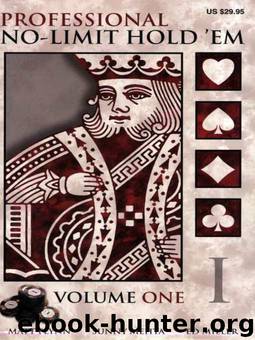Professional No-Limit Hold 'em: Volume I by Flynn Matt & Mehta Sunny & Miller Ed

Author:Flynn, Matt & Mehta, Sunny & Miller, Ed [Flynn, Matt]
Language: eng
Format: mobi
Publisher: Two Plus Two Publishing
Published: 2007-07-19T16:00:00+00:00
Balancing Risk Versus Reward
Say you are dealt
in the big blind in a $5-$10 game with effective stacks of $5,050. The small blind completes, and you raise to $50. The small blind calls. The flop comes
The pot is $100. Your opponent goes all-in for $5,000. Should you call? Are you committed?
No, putting $5,000 into a $5,100 pot on such a threatening board is a bad idea. All you have is an overpair with no redraw (i.e., no spades and no straight cards).
What if you instead had only $50 left? Would you be committed? Yes, you would have enough equity against your opponent’s range to justify getting all-in at 3-to-1.
So what changed? Obviously the stack sizes did. But what really changed was your risk relative to your reward. With $5,000 remaining, your risk was high compared to the size of the pot. With only $50 remaining, your relative risk was much smaller.
Every commitment decision is a balance of the risk versus the reward of getting all-in. The risk is what’s left to bet, which is the remaining smaller stack. The reward is the pot.
You can express any commitment decision — the risk versus reward of getting all-in — as a simple ratio. You divide the remaining smaller stack by the current pot size.41
You want to plan hands around the possibility of getting all-in. That means achieving the right balance of risk versus reward. But how exactly do you do that? Let’s start with a hand that’s out of balance.
Download
This site does not store any files on its server. We only index and link to content provided by other sites. Please contact the content providers to delete copyright contents if any and email us, we'll remove relevant links or contents immediately.
The Infinite Retina by Robert Scoble Irena Cronin(6216)
Harry Potter and the Cursed Child: The Journey by Harry Potter Theatrical Productions(4467)
The Sports Rules Book by Human Kinetics(4344)
Molly's Game: From Hollywood's Elite to Wall Street's Billionaire Boys Club, My High-Stakes Adventure in the World of Underground Poker by Molly Bloom(3510)
A Knight of the Seven Kingdoms by George R R Martin(3224)
Quidditch Through the Ages by J.K. Rowling(3084)
How To by Randall Munroe(3074)
Flowers For Algernon by Daniel Keyes(3050)
Quidditch Through the Ages by J K Rowling & Kennilworthy Whisp(2948)
Stacked Decks by The Rotenberg Collection(2843)
Quidditch Through the Ages by Kennilworthy Whisp by J.K. Rowling(2831)
Quidditch through the Ages by J. K. Rowling(2781)
Quidditch Through The Ages by J. K. Rowling(2745)
776 Stupidest Things Ever Said by Ross Petras(2742)
Ready Player One: A Novel by Ernest Cline(2674)
What If?: Serious Scientific Answers to Absurd Hypothetical Questions by Randall Munroe(2670)
Beautiful Oblivion by Jamie McGuire(2585)
The Book of Questions: Revised and Updated by Gregory Stock Ph.d(2542)
Champions of Illusion by Susana Martinez-Conde & Stephen Macknik(2436)
